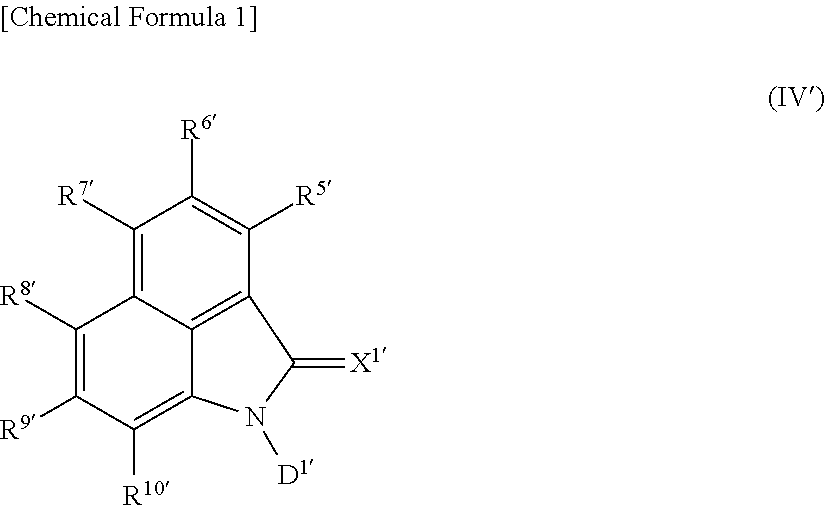Polymerizable liquid crystal composition, polarized light-emitting coating material, novel naphtholactam derivative novel coumarin derivative, novel nile red derivative, and novel anthracene derivative
a technology of liquid crystal composition and polarized light-emitting coating, which is applied in the direction of instruments, polarising elements, optical elements, etc., can solve the problems that literatures do not disclose or suggest polarized light-emitting devices, and achieve high degree of polarization
- Summary
- Abstract
- Description
- Claims
- Application Information
AI Technical Summary
Benefits of technology
Problems solved by technology
Method used
Image
Examples
example 1-1
Synthesis of Compound B-33
[0311]Compound B-33 was synthesized according to the process described below.
[0312]A three-neck flask was charged with mesyl chloride (0.14 g, 0.0012 mol) and tetrahydrofuran (THF) (4.29 g), and the mixture was cooled to −30° C. in a nitrogen atmosphere. To the reactive solution was added dropwise a suspension of intermediate 1 (300 mg, 0.001 mol) represented by the formula below and triethylamine (TEA) (0.12 g, 0.012 mol) in THF (4.29 g). After the mixture was stirred for 3 hours, TEA (0.12 g, 0.0012 mol) and butanol acrylate (0.14 g, 0.001 mol) were added to the mixture, and the mixture was returned to room temperature and stirred overnight. Chloroform and water were added to the mixture, and oil-water separation was performed until neutralization was completed. The organic solvent was removed by distillation. After the residue was separated by silica gel column chromatography (eluent: chloroform), the separated product was crystallized from methanol to g...
example 1-2
Synthesis of Compound B-35
[0314]Compound B-35 was synthesized according to the process described below.
[0315]A three-neck flask was charged with mesyl chloride (0.34 g, 0.003 mol) and THF (6.18 g), and the mixture was cooled to −30° C. in a nitrogen atmosphere. To the reactive solution was added dropwise a suspension of intermediate 2 (0.73 g, 0.0025 mol) represented by the formula below and TEA (0.03 g, 0.003 mol) in THF (6.18 g). After a solution of TEA (0.03 g, 0.003 mol) and N,N-dimethylaminopyridine (DMAP) (0.003 g) in THF (6.18 g) was further added to the mixture, a solution of intermediate 3 (0.86 g, 0.0025 mol) represented by the formula below in THF (6.18 g) was added to the mixture. The mixture was returned to room temperature and stirred overnight. After chloroform and water were added to the mixture, oil-water separation was performed, and the organic solvent was removed by distillation. After the residue was separated by silica gel column chromatography (eluent: chlorof...
examples 1-3 to 1-9
Synthesis of Compounds B-169 to B-175
[0318]Compound B-169 was synthesized according to the process shown below.
[0319]
[0320]A 300 ml four-neck flask was charged with salicylaldehyde (2.93 g, 0.024 mol), benzyloxyphenyl acetate (4.85 g, 0.02 mol), sodium acetate (3.28 g, 0.040 mol), and acetic anhydride (26.27 g), and the mixture was heated at 130° C. for 5 hours. The product was added dropwise to an aqueous sodium hydroxide solution. The resultant white precipitate was separated by filtration and washed with methanol under reflux. The white solid was then separated by filtration to give 2.4 g of intermediate 4 represented by the formula below (36.5% yield).
[0321]
[0322]
[0323]A 300 ml four-neck flask was charged with intermediate 4 (2.17 g, 0.066 mol) obtained in step 1 and anisole (9.43 g). An anisole solution (1.57 g) of aluminum chloride (0.44 g, 0.033 mol) was added dropwise to the mixture and heated at 85° C. for 1 hour. Chloroform and water were added to the mixture, and the orga...
PUM
| Property | Measurement | Unit |
|---|---|---|
| temperature | aaaaa | aaaaa |
| absorption wavelengths | aaaaa | aaaaa |
| particle sizes | aaaaa | aaaaa |
Abstract
Description
Claims
Application Information
 Login to View More
Login to View More - R&D
- Intellectual Property
- Life Sciences
- Materials
- Tech Scout
- Unparalleled Data Quality
- Higher Quality Content
- 60% Fewer Hallucinations
Browse by: Latest US Patents, China's latest patents, Technical Efficacy Thesaurus, Application Domain, Technology Topic, Popular Technical Reports.
© 2025 PatSnap. All rights reserved.Legal|Privacy policy|Modern Slavery Act Transparency Statement|Sitemap|About US| Contact US: help@patsnap.com



